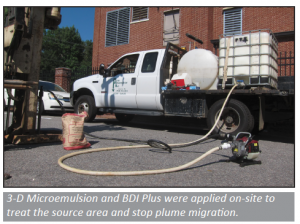Enhanced Reductive Dechlorination with Bioaugmentation Treats Source Area, Stops Plume Migration
Combined Remedy Source Treatment Applied at Florida Dry Cleaner
Project Highlights
- Aggressive source treatment to deplete the high-concentration PCE mass
- Plume treatment with a permeable reactive barrier to cut off the plume
- Low-impact direct-push injections in both areas

Project Summary
A former dry cleaner in an urban setting in central Florida was contaminated with a PCE plume that extended nearly 1,000 feet downgradient from the source. An extensive treatability test involving multiple emulsified vegetable oils and other electron donor technologies indicated that 3-D Microemulsion® would perform best at the site. An enhanced anaerobic bioremediation treatment was implemented in two areas – the source area near the dry cleaner and an area approximately 500 feet downgradient. A total of 13,900 gallons of 3-D Microemulsion was injected into 30 direct push points in the two areas. In addition, 97 liters of Bio-Dechlor INOCULUM Plus (BDI® Plus) bioaugmentation culture was injected to accelerate treatment results.
Remediation Approach
The injections were performed near the former dry cleaner to deplete the source mass and expedite a transition into natural attenuation monitoring. A plume treatment was implemented as a permeable reactive barrier approximately 500 feet downgradient to help mitigate the risk of additional downgradient migration. Injections were completed using direct-push technology.
Technology Description
3-D Microemulsion is an engineered electron donor technology that offers a novel 3-stage electron donor release profile pH-neutral chemistry, and unique subsurface distribution properties.
Bio-Dechlor INOCULUM Plus is a natural microbial consortium containing species of Dehalococcoides sp. (DHC). This microbial consortium has since been enriched to increase its ability to rapidly dechlorinate contaminants during in situ bioremediation processes.


 Americas
Americas Europe
Europe Français
Français Deutsch
Deutsch Italiano
Italiano Español
Español


